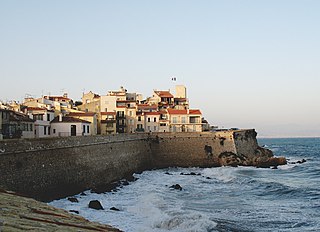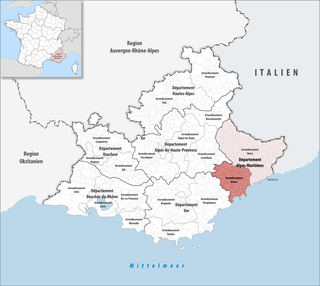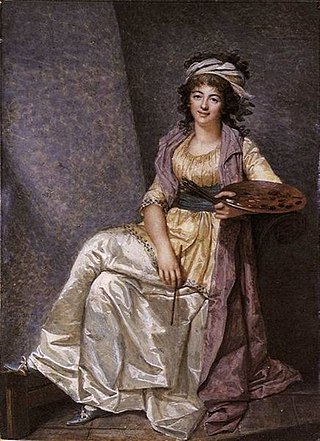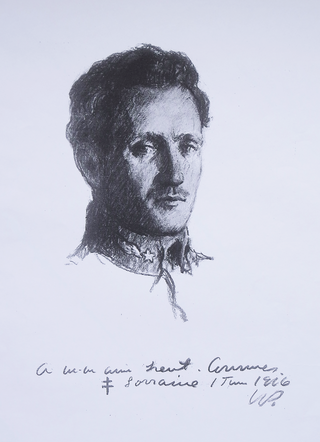
Grasse is the only subprefecture of the Alpes-Maritimes department in the Provence-Alpes-Côte-d'Azur region on the French Riviera. In 2017, the commune had a population of 50,396.

Antibes is a seaside city in the Alpes-Maritimes department in Southeastern France. It is located on the French Riviera between Cannes and Nice; its cape, the Cap d'Antibes, along with Cap Ferrat to the northeast, is one of the best known landforms in the area. The capes house the Hôtel du Cap-Eden-Roc and Grand-Hôtel du Cap-Ferrat respectively, widely considered two of the most exclusive hotels in the world.

Maximin Isnard, French revolutionary, was a dealer in perfumery at Draguignan when he was elected deputy for the département of the Var to the Legislative Assembly, where he joined the Girondists. As the president of the National Convention Isnard, who had enough of the tyranny of the Paris Commune, threatened the destruction of Paris. He declared that the Convention would not be influenced by any violence and that Paris had to respect the representatives from elsewhere in France. Isnard was asked to give up his seat.
Continuation of the Séminaire Nicolas Bourbaki programme, for the 1960s.

The arrondissement of Grasse is an arrondissement of France in the Alpes-Maritimes department in the Provence-Alpes-Côte d'Azur region. It has 62 communes. Its population is 561,067 (2016), and its area is 1,231.2 km2 (475.4 sq mi).

Stade Lavallois Mayenne Football Club, also referred to as Stade Lavallois or simply Laval, is a French association football club based in Laval in western France. The club was formed on 17 July 1902 and currently plays in Ligue 2, the second level of French football. Laval plays its home matches at the Stade Francis Le Basser located in the city.

The Diocese of Saint-Flour is a Latin diocese of the Catholic Church in France. The diocese comprises the department of Cantal. Erected in 1317, the diocese was suffragan of the Archdiocese of Bourges until 2002. With the general reorganization of the structure of the French church by Pope John Paul II, Saint-Flour became the suffragan of the Archdiocese of Clermont. The seat of the bishop is located in Saint-Flour, Cantal.

The former French Roman Catholic Diocese of Saint-Paul-Trois-Châteaux, sometimes, just like the town, also known as the Diocese of Saint-Paul-en-Tricastin, existed from the sixth century to the French Revolution.

The former French Catholic diocese of Grasse was founded in the 4th or 5th century as the diocese of Antibes. It was originally suffragan to the Archbishop of Aix, and then to the Archbishop of Embrun. The see moved from Antibes to Grasse in 1244. It remained at Grasse Cathedral until the French Revolution. The diocese was suppressed by the Concordat of 1801, its territory passing to the diocese of Nice.

Courmes is a commune in the Alpes-Maritimes department in the Provence-Alpes-Côte d'Azur region in Southeastern France. It is part of Préalpes d'Azur Regional Natural Park. In 2020, Courmes had a population of 108.

Marguerite Gérard was a French painter and printmaker working in the Rococo style. She was the daughter of Marie Gilette and perfumer Claude Gérard. At eight years old, she became the sister-in-law of Jean-Honoré Fragonard, and when she was 14, she went to live with him. She was also the aunt of the artist Alexandre-Évariste Fragonard. Gérard became Fragonard's pupil in the mid-1770s and studied painting, drawing and printmaking under his tutelage. Gérard and Fragonard created nine etchings in 1778. Historians currently believe Gérard was the sole artist of five of these etchings, since many have a duplicate created by her tutor Fragonard. More than 300 genre paintings, 80 portraits, and several miniatures have been documented to Gérard. One of her paintings, The Clemency of Napoleon, was purchased by Napoleon in 1808.

The Albert Londres Prize is the highest French journalism award, named in honor of journalist Albert Londres. Created in 1932, it was first awarded in 1933 and is considered the French equivalent of the Pulitzer Prize. Three laureates are awarded each year. The three categories are : "best reporter in the written press", "best audiovisual reporter" and "best reporting book".
Christiane Ziegler, is a French Egyptologist, curator, director emeritus of the Department of Egyptian Antiquities of the Louvre Museum and editorial director of the archaeological mission from the Louvre Museum at Saqqara, Egypt.

Freddy Buache was a Swiss journalist, cinema critic and film historian. He was the director of the Swiss Film Archive from 1951 to 1996. He was a privatdozent at the University of Lausanne.

Jean-Baptiste Pastré was a French banker and arms-dealer from Marseille. A merchant banker in Egypt, he founded the Anglo-Egyptian Bank in 1862. He also served on the City Council of Marseille.
The prix Broquette-Gonin was a former prize awarded by the Académie française.
Babine is a Canadian fantasy drama film, directed by Luc Picard and released in 2008. Adapted from Fred Pellerin's book Il faut prendre le taureau par les contes, the film stars Vincent-Guillaume Otis as Babine, the village idiot of Saint-Élie-de-Caxton, Quebec. A lifelong outcast because his mother was believed to be the town witch, he becomes the immediate suspect when the town's church catches fire, killing the parish priest. However, he will receive the support of the village's merchant, Toussaint Brodeur, as he attempts to prove his innocence.

Jean-Baptiste-Sauveur Gavaudan was a French opera singer who sang leading tenor roles, primarily with the Opéra Comique in Paris. He was particularly known for his skill as an actor and was sometimes referred to as "the Talma of the Opéra Comique". He also served as the director of the Théâtre Royal de la Monnaie in Brussels for the 1817–1818 season. Born in Salon-de-Provence, he made his stage debut in 1791 at the Théâtre Montansier. Gavaudan was married to the soprano Alexandrine Marie Agathe Gavaudan-Ducamel from 1798 until his death in Paris at the age of 67.

Marcel Louis Henry Joseph Léon Courmes was a French officer and aviator during the First World War. He subsequently became one of the first French sound cinematographers.

Claude-Marie Courmes was a French merchant, shipowner and politician.





















